
| ||||||||||||
| Total population | ||||||||||||
|---|---|---|---|---|---|---|---|---|---|---|---|---|
| unknown | ||||||||||||
| Regions with significant populations | ||||||||||||
| ||||||||||||
| Languages | ||||||||||||
|
Tausūg, Maguindanaoan, Maranaoan, Bajau-Sama languages, Yakan, other Austronesian languages of Mindanao | ||||||||||||
| Religion | ||||||||||||
|
Sunni Islam | ||||||||||||
| Related ethnic groups | ||||||||||||
The Moro people (Malay: Orang Moro, Spanish: pueblos moros, Filipino: Mamamayang Moro) are the native Muslim inhabitants living in the Philippine Archipelago, whom most live in southwestern Mindanao, Sulu Archipelago with a small community in the Quiapo district of Manila, southern Palawan and the northeastern parts of Borneo. The Moro people are those that stood through Spanish conquest through constant armed resistance against the conquistadors with the establishment of sultanates and Islamic states in the southern Philippines.
As Moros are understood to be a distinct ethnic group, Filipinos who convert to Islam are normally not included.
Etymology[]
The term Moro was a Spanish word used to refer to the Iberian Moors, the Muslims of Spain. When they arrived in the Philippines, they used the same word to refer to the Muslim natives of the islands, surprised and angered by a high Muslim presence after having defeated and expelled them from Spain. The term is still used for the Muslims of the Philippines today.
Moros are also commonly known as Filipino Muslims, by outside sources. However, most Moros do not refer to themselves Filipinos since the term originated from King Philip II of Spain who expelled Islam from Spain and is the namesake of Philippine islands. Most of the Muslims that do refer to themselves as Filipinos are converts to Islam living in Luzon, Visayas and Quiapo district or ex-patriats from Muslim countries.
Royal Titles[]
The sultanate system is still part of the culture of Mindanao's Muslims. Unlike the other Filipinos, who commonly adopted Spanish royal titles after converting to Christianity, the Muslims of Mindanao retained those passed on by Malay missionaries which themselves were of Indian influence.
The title sultan is more often used to refer to the Muslim nobility of the Philippines, but many of them actually retained their pre-Islamic titles such as rajah and maharaja which were honorific Hindu and Indian titles.
The term maharaja originated from the Srivijayan and Majapahit era, and remained in use by the Sultanate of Sulu which referred to rulers of provinces.
The term datu was an exclusively native title used by nobilities and chiefs of all sorts, either Muslim or non-Muslim, it is similar to the term datuk used by ethnic Malay civilizations (not to be mistaken for Malay Race).
History[]
Ancestry and Pre-Islamic History[]
The Moro people are Austronesian groups, and are related to Filipinos and Malays alike who are descended from southern tribes in China, mostly from Taiwan and Madagascar in Africa. Many of the Moro groups are descended from Malay, Arab and Indian migrants, especially for the inland groups such as the Maguindanaoans of Maguindanao and the Maranaoans of the Lanao region. These people were mostly Animistic and Pagan tribes. Buddhism and Hinduism arrived through Malay traders and missionaries who introduced the royal titles (of Indian origin of course) rajah, maharaja and the native term datu which came to be a common title among the Malay Race.
Introduction of Islam[]
The Sulu Archipelago was the sight of heavy Islamic activity. In 1380 A.D., an Arab scholar and a judge by the name of Karim ul' Makdhum (spelled as Karimul Makhdum in Pilipino) from Mecca arrived in the Sulu Archipelago and Mindanao through Borneo. Ul' Makdhum's arrival marked a dawn of Islam in the Philippines. Makdhum was liked and loved all around in Mindanao and the Sulu Archipelago, he stayed in the southern Philippines and died there of old age.[13] A decade later, native Muslims from the neighboring Indonesia and Malaysia arrived in the Philippines to strengthen the religion's hold of the islands. A Minangkabu prince from Sumatra by the name of Rajah Baguinda, arrived with his followers to the islands and preached Islam.[14] In 1500, a Malay-Arab missionary from Johor by the name of Sharif Kabungsuwan (Jawi: شريف كبوڠسووان) arrived in Mindanao. Kabungsuwan's arrival further strengthened Islam in Mindanao and ensured its hold of Mindanao.[15] Islam arrived in the Manila Bay area when Bolkiah, Brunei's sultan occupied kingdoms located there - Maynila and Tondo and turned them into vassal states for the Brunei sultanate. Salila, Maynila's ruler converted to Islam and adopted the Arabic name Sulaiman.
Rise of Muslim States in the Philippines[]
The rajahs and datus of western Mindanao and the Sulu Archipelago adopted Indo-Islamic traditions, and took the title sultan, traditional Muslim rulers who governed states known as sultanates. Malay and Arabic were the two official major langauges adopted by these various sultanates and Muslim rajahnates.
Sultanate of Sulu[]

Sultanate of Sulu flag
In the Sulu Archipelago, another Arab and an acclaimed-descendant of the Islamic prophet Muhammad by the name of Sayyid Abu Bakr Abirin established the Sultanate of Sulu (Jawi: سلطنة سولو دار الإسلام, Arabic: سلطنة سولو) in 1457 after his fascination with the natives.[16] Abirin was actually born in the Malacca sultanate, not in Arabia. He was coronated under the name Sharif ul-Hāshim, because of his acclaimed descent from the Arabian tribe Banu Hashim. The Sultanate of Sulu was a Tausūg state that covered the Sulu Archipelago, Palawan (according to some sources) and the northern part of Borneo in Malaysia and emerged to be a major power in Maritime Southeast Asia. Provincial princes of this sultanate retained the pre-Islamic title maharaja. Jolo and for some time, Palawan was established as the capital of the Sulu Sultanate.
Sultanate of Maguindanao[]
The Sultanate of Maguindanao started out as a Malay Muslim state, but the Maguindanaoans later emerged into a
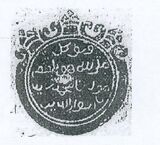
Seal of Maguindanaoan sultan Datu Uto
seperate ethnic group. Kabungsuwan established the Sultanate of Maguindanao (1500-1898 A.D.) with Cotabato City becoming the capital. Sharif Kabungsuwan later influenced the formation of sultanate confederations in Lanao, which were largely decentralized.17] Maguindanao was the largest Muslim state in Mindanao, spanning the entire southern half of Mindanao including the Zamboanga Peninsula ans parts of the northern Maluku Islands in Indonesia.
Confederation of Lanao Sultanates[]
Like Maguindanao, the Lanao natives are of Malay origin and their sultanates were formed during the Spanish colonial era. The first Lanao sultan was crowned in 1640, a Maranaoan chief by the name of Balindong Bzar. The Lanao sultanates were uniquely decentralized and was divided into Four Principalities of Lanao, composed of sixteen royal houses. Each principality was referred to as a Pangampong, and governed by an individual with the title His Royal Highness, an actual sultan with civil powers was distinguished from a figure-head royal sultan. The capital of the Lanao Sultanates was Marawi City, which was then called Dansalan.
Kingdom of Maynila/Selurong[]
Manila (also known as Maynila in Tagalog and Selurong or Seludong in Malay) became a Muslim state through its acquiring as a vassal state by Sultan Bolkiah of Brunei. After Rajah Sulayman converted to Islam, he adopted Islamic politics into the kingdom although he never officially adopted the title "sultan" and his domain remained a rajahnate and not a sultanate. He was also a descendant of the Bruneian royal family of Bolkiah. The Islamic Tagalog kingdom known as the Rajahnate of Maynila was carved out of the once Buddhist-Hindu rajahnate of the same name that splintered from the Namayan kingdom; it covered the araas of Manila Bay, the Pasig Rivera area and parts of what is today Pampanga in the Philippines. Bolkiah renamed Manila to Selurong or Seludong. Its neighbor was the Kingdom of Tondo, ruled by his brother Lakan Dula. Manila today is the capital of the Republic of the Philippines.
War Against Spanish Conquest[]
In 1521, the Portuguese conquistador Ferdinand Magellan arrived in the Visayan island of Mactan where he met its datu, Lapu-Lapu or Ali Pulako. Magellan had befriended the other datus and rajahs of Visayas, Humabon ordered Lapu-Lapu to submit to Spain's rule and convert to Roman Catholicism but Lapu-Lapu refused and killed Magellan in battle, although no record ever indicates Lapu-Lapu's religion despite being an acclaimed Muslim by Islamic souces it is much more likely that Lapu-Lapu was an Animist or a Hindu. Spain returned by sending conquistador Miguel López de Legazpi to conquer Luzon and Visayas, after converting their native rulers to Roman Catholicism and attacking those that refused. The Muslim natives of the Philippines actively resisted Spanish attempts to convert them to Roman Catholicism declaring a jihad or holy war against Spanish conquest.
Sulayman Revolt in Luzon[]
In Luzon, Lakan Dula, Tondo's ruler submitted to Spain's rule and converted to Roman Catholicism and baptized as
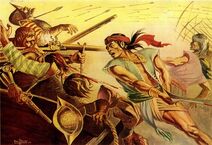
Sulayman Revolt
Don Carlos Lakandula. Rajah Sulayman refused to submit to Spain's rule or convert to Roman Catholicism, but he did allow them access into Luzon for a period of time. Sulayman eventually decided to rebel against Spain's rule, and along with Lakan Dula, waged a war against them after Spanish atrocities. Juan de Salcedo, Legazpi's grandson however signed a treaty with both Rajah Sulayman and Lakan Dula which gave the colonists occupation of the Muslim settlements south of the Pasig River.[2] Another individual, allegedly a Kapampangan chief from Macabebe by the identified name of Tarik Sulaymen continued the revolt and waged a battle against Spanish forces in the Bangkusay Channel in Tondo, but because Lakan Dula had already given Spain strategic access to Luzon, Sulayman was defeated in the Battle of Bangkusay due to Spain being one step ahead.[3] Tarik Sulayman's failure had initially ended Muslim resistance against Spain in Luzon, and without leaders, the other Muslim tribes of Luzon were either easily defeated in battle or converted to Roman Catholicism although Spain would deal with latter revolts from the Christianized natives, these were put down quickly. There is some contrevoursy as to whether Tarik Sulayman of Macabebe is the same person as Rajah Sulayman of Manila, and there is a confusion between both because of the similarity of names, they both bear the name Sulayman.
Spanish-Moro Conflict in Mindanao[]
The Muslims of the southern Philippines also resisted Spanish conquest and had a strategic advantage over Spain since Spain was not too familiar with Mindanao and their chiefs were not willing to give Spain access and showed instant resistance. Muhammad
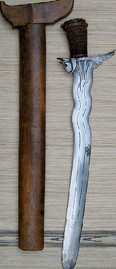
The kriss sword was used by the sultans to fight the Spanish conquest
Dipaduan Kudarat, the fifth Sultan of Maguindanao halted Spanish missionaries into his territory and attacked Spanish garrisons in Mindanao. The sultans of Sulu also joined in the Moro resistance against Spain. The Moros conducted vicious attacks against Spanish and Filipino Christian settlements, as far north as Visayas and Manila in Luzon, a former Islamic kingdom (Bruniean sattelite state) that Spain quickly converted to Roman Catholicism after conquering. The Moro raids would persist, which for some time, retained the presence of Islam in Manila. Brutal fighting between the Spanish conquistadors and the armies of Mindanao's sultans would persist for three centuries and it took Spain extensive use of its military resrouces to complete its conquest of Mindanao. The Chinese provided military aid to Sulu's armies, and Chinese pirates and rebels also aided the Moro armies of Mindanao against Spain. The success of the Moro armies would end when Spain destroyed Chinese aid to Sulu, however their holy war against Spain would continue. There were some instances when Mindanao's sultans allowed Christian missionaries into Mindanao, such as Azim ud-Din I of Sulu or Muhammad Alimuddin. His brother, Bantilan exiled him to Manila and expelled Christian and Jesuit missionaries from the sultanate. While Spain did achieve strategic success against the Moros, they had to accept the fact that the Moros would never give up their Islamic faith and would rather die to the last man rather than convert to Roman Catholicism as had Rajah Sulayman and Tarik Sulayman. Spain was forced to accept the Muslim presence in the newly acquired territory they would call the Philippine Islands. However despite the Spanish failure to convert the Moros to Roman Catholicism, Mindanao and the Sulu Archipelago had to deal with the constant presence of Jesuit missionaries who were actually very successful in converting entire families and clans to Roman Catholicism which once more, threatened the presence of Islam in the southern Philippines.
War Against American and Japanese Conquest[]
In 1898, the Americans defeated the Spanish armies in the Spanish-American War of the same year, acquiring the Philippine Islands. The Americans battled Filipino forces led by Emilio Aguinaldo in Luzon and defeated them. However, the Moro people waged an independant war against the Americans that had no correlation with the armed Filipino revolution against the American forces. In 1903, a band of Maranaoans attacked American troops in Lake

Cornelius C. Smith (far right), a recipient of the Medal of Honor, as commander of the Philippine Constabulary with Brig. Gen. John J. Pershing and Moro chieftains in 1910
Lanao. The Moros fought with the same weapons they had with Spain's armies, swords and daggers mostly which contributed their decisive loss in the Battle of Bud Dajo in Jolo Island. Because of the high death of woman and children, criticisms were met against Leonard Wood, the American general who led military campaigns in Mindanao.[4] Leonard Wood, the U.S. general responsible for campaigns in Mindanao recieved negative criticisms from the American public and Leonard Wood would control the Moro Province which became designated as Moroland. The civil powers of Mindanao's sultans declined rapidly and were given little pay. However through, Wood allowed the Moros to establish their own laws, seperate from Philippine law. Moro rulers, datus and sultans were given the roles of governers, town mayors and military leaders. In 1941, the Japanese Empire invaded the American-held Philippine Archipelago. The American soldiers stationed in the Philippines were helpless, but dedicated enough to hold the Japanese for appoximately four years until they finally surrendered Bataan which force the Filipinos to rely on insugency groups known as guerillias, these militants carried out hit-and-run style of warfare agianst Japanese bases. This type lf warfare was especially predominant with the Moros of Mindanao, who resisted Japanese rule.[5]
The Republic of Zamboanga[]
In 1899, the Zamboanga Peninsula was established after the native Zamboangueños rebelled against the Spanish government. This republic was highly Latin-influenced, with Chavacano and Spanish as its official languages. Although Zamboanga was ruled by Christian political families, many Moros remained in the Zamboanga Peninsula where they absorbed the Latin influence. During the American colonial era, Zamboanga became the Moro capital.
Within the Republic of the Philippines[]
After the the Republic of the Philippines formed in 1946, after being freed from Japanese rule by the Americans in 1945, the Moros along with their Lumad counterparts (non-Muslim natives in Mindanao remained seperated from mainstream Filipino society and were discriminated, because of the tendancy of Philippine politicians to favor promoting Roman Catholicism as the state religion, although the Philippines had no state religion. Their culture was ignored. The Moros of the southern Philippines formed several independance movements from the Republic.[6][7] During the presidency of Ferdinand Marcos, the Philippine government also promoted the mass migration of Catholics (mostly Tagalog, Cebauano and Ilocano people) to the impoverished parts of Mindanao, often settling in Muslim territory and eventually came to outpopulate the native Muslims of Mindanao. Key cities that were capitals of former sultanates such as Zamboanga City and Davao City became predominantly Christian cities with remaining Muslim minorities as had Manila.
Moro Independance Movements[]
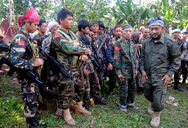
Members of the Moro National Liberation Front
The Moros were poignant enough to attain their independance from the Philippines, that they formed militant groups that fought against the Filipino armed forces. In 1973, Ferdinand Marcos imposed martial law which led to the creation of the Moro National Liberation Front by freedom fighter Nur Misuari who was prominent in Mindanao. The government did offer autonomy and self-determination to the Moro people, but they rejected it and created the large militant force that carried out insurgencies against Filipino Christians and Filipino soldiers. They also attacked government facilities. In 1986, Marcos' succeeding president Corazon Aquino and Nur Misauri signed a cease-fire, which was brokered by Libyan president Muammar Gaddafi.[8] In 1977, a seperate militia force known as the Moro Islamic Liberation Front (Arabic: جماعة أبو سياف) or the MILF, in 1984, was created by Hashim
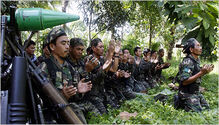
Members of the Moro Islamic Liberation Front
Salamat and fifty seven officers from the MLNF after Misuari expelled Salamat from the MNLF. In 1987, the Autonomous Region of Muslim Mindanao or the ARMM was created, which today consists of the provinces of Maguindanao, Lanao del Sur, Basilan and Tawi-Tawi which contained the predominantly Muslim regions of Mindanao, although large pockets of Muslims lived outside of the region. Supporters of the Moro National Liberation Front and the Moro Islamic Liberation Front called this region Bangsamoro, the word bangsa is a Malay word for "nation" and the Spanish word for a Filipino Muslim known as the moro. The areas and territories claimed by supporters of the Bangsamoro state far-encompass

Flag of the Bangsamoro Republik
that provinces included the ARMM and include predominantly Christian regions such as Palawan and Davao. In 1991, the Abu-Sayyaf (Arabic: جماعة أبو سياف) group was formed and has far-more committed more acts of terror among innocent people and has have formed alliances and connections with Indonesian militant groups such as the Laskar Jihad.
Sabah and North Borneo Issue[]
On a historical level, there is another independance and armed movement that deals with the acclaimed descendants of the Sulu Sultanate, there are multiple claimants as to who belongs to the throne of Sulu, and it
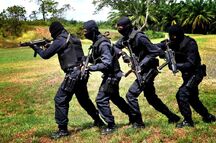
Malaysian police en route to find and fight Moro rebels
involves the Malaysian state of Sabah. Claimants of the Sulu Sultanate believe Sabah to be their rightful territory, but success could not be achieved since multiple militants have different goals. Supporters of the Bangsamoro support the creation of an independant state that comprises of Mindanao, the Sulu Archipelago and Palawan while supporters of the Sulu Sultanate also involve Malaysian claimants who are dedicated to establishing an independant Tausūg state, from both the Philippines and Malaysia and other militants are dedicated to annexing Sabah as a Philippine province. Unlike the other Moro militants, those trying to reclaim and revive the Sulu Sultanate refer to themselves as the Royal Sulu Army.
Maguindanao Massacre[]
The horrific incident known as the Maguindanao Massacre was committed not as a result of a Muslim-Christian rivarly but rather rivalling political families in Mindanao, both Muslim families. The Ampatuans had been the powerful political family of Maguindanao and have controlled the province since 2001 and their biggest rivals were the Mangudadatu and Mastura families.[9] On November 23, 2009, 100 armed men abducted and attacked a convoy carring thirty seven journalists that was invited to Mindanao by Esmael Mangudadatu, who was the vice mayor of the Buluan municipality (an urban division with a corporate status) in Maguindanao. Most of its members were killed.[10] There was also evidence of rape against the women in the convoy, four being raped before killed. Other graphic and horrific and inhumane acts of torture were committed in the attack.[11] The massacre led to the expulsion of many Ampatuan family members from Philippine political groups, namely the Lakas Christian-Muslim Democras or Lakas CMD, a unified center-right political party that implements both Christian and Islamic ideology for the unification of Muslim and Christian Filipinos. Andal Ampatuan Jr., who was the mayor of the Datu Unsay municipality was charged with murder.[12] Glorya Macapagal-Arroyo, the Philippine president declared martial law in Maguindanao thereafter.
Modern-Days[]
Islam is the second fast-growing religion in the Philippines.[13] The Muslim culture of the Philippines have somewhat experienced a semi-revival. On February 18, 2010, then-president Glorya Macapagal-Arroyo signed Republic Act of 9997, replacing the Office of Muslim Affairs to National Commission on Muslim Filipinos which promoted Filipino Muslims' rights on a national and local level which includes the hajj, or the pilgrimage to Mecca which is Islam's holiest city.[14] Muslims have also been put into political power in western Mindanao, these are descendants of sultans who ruled the southern Philippines and some even control predominantly-
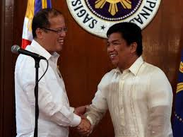
ARMM regional governer Mujiv Hataman with President Benigno Aquino
Christian cities. However, it is simply too late for many of the seperatist groups of Mindanao who still wish to established an independant Bangsamoro state and those of the Royal Sulu Army wishing to re-establish te Sultanate of Sulu. The district of Quiapo today has sizable Muslim population in Manila. Sultan Bolkiah of Brunei funded the building a large mosque in Cotabato City, named after him, which is now the largest mosque in the Philippines.[15]
Despite the encouragement of Muslim culture, the crisis of independance war in Mindanao and Sulu Archipelago still rages on following more insurgencies by Moro militants and incursions by Filipino troops, causing more casualities and displacing many people out of their homes. The two worse included an armed Moro incursion into the Malaysian district of Lahad Datu in February 2013 killing many Malaysian policemen and in Zamboanga City in September 2013 where Moro and Filipino forces clashed. The Moros were unsuccessful in both battles.
Lahad Datu and Zamboanga City Standoff - February-September 2013[]
In 2013, Moro groups waged a series of unsuccessful battles in both the Philippines and Malaysia. On February 11, 2013, 101 armed militants who referred to themselves as the Royal Sulu Army, sent by the late Jamalul Kiram III, a claimant to the Sulu Sultanate, arrived by boats from the island of Tawi-Tawi in the Sulu Archipelago to carry out their will to retake Sabah. Agbimuddin Kiram, Jamalul's chosen crown prince and heir to the throne at the time was chosen to lead the group himself and led to the group to the Malaysian district of Lahad Datu in the state of Sabah. The Malaysian police surrounded the Moro groups in Lahad Datu, and was also accompanied by some neighboring Philippine forces. The Malaysian armed forces were successful in carrying out the operations to route and stop the militants. On September 2013, the Moros began another attack back at home in Zamboanga City, one of Mindanao's major economic centers. This time, Nur Misuari of the Moro National Liberation Front was the perpetuator of the battle. On September 9, 2013 the Moro militants tried to hoist their flag on top of the Zamboanga City Hall for the intent of establishing a Bangsamoro Republik, rather than a historical sultanate.[16] Like the Malaysian troops in Sabah, the Filipino forces and police in Mindanao were successful in routing the militants and retaking territories that the MNLF had attacked. The battle was also marked by unified attacks among other Muslim militant groups in the Philippines, including rogue-MNLF factions and terrorist groups such as the Abu-Sayyaf.
Language[]
The Moro people are mostly speakers of Austronesian languages. The most-spoken native languages of the Moro are the Maguindanaon, Tausūg and Maranao languages. The Maguindanao language is spoken in the Maguindanao Province, the Maranao language is predominant in the Lanao region, and is the majority spoken in Lanao del Sur and the Tausūg language is spoken in the Sulu Archipelago with speakers in the Zamboanga Peninsula and the Malaysian state of Sabah.
Other Austronesian languages spoken by their respective tribes are the Sama-Bajau languages, Yakan and Kalagan.
Spoken is also the Filipino language, which is based on a native dialect from Luzon known as Tagalog, for the sake of living in the Philippines.
Because of the mass influx of Cebuano migrants in Mindanao, many of the Moros tend to be exposed to the Cebuano language from Visayan easily enough to be able to speak it, especially with the Tausūg since Tausūg is a dialect of Visayan.
A sizable minority can still speak the Malay language, also an Austronesian language which was the once the lingua franca the Philippine Archipelago prior to conact with Spain. Arabic, a central Semitic language is also spoken by a minority of the Moro people. Historically, amid Spanish conquest, Malay and Arabic were the lingua francas of the sultanates in Mindanao. Today, many Moro merchants use Malay to converse with citizens of the neighboring Malay-speaking nations of Malaysia and Indonesia. Most of the Malay-speaking Muslims of the Philippines are those in the southern parts of the Zamboanga Peninsula, the Sulu Archipelago and the southern predominantly Muslim-inhabited municipalies of Bataraz and Balabac in Palawan.
Chavacano (sometimes spelled as Chabacano or Chabakano) is a Philippine Spanish Creole, that gained popularity as a Philippine major language during the short-lived Republic of Zamboanga. Most of the Moros have also attained the ability to speak this language, specifically the Zamboanga dialect known as Zamboangueño especially those that live in Zamboanga.
Most of the languages of the Moro people are written in the Latin script. However, an Arabic script known as Jawi is used to write the Tausūg language, which itself was for the Malay language. Attempts are being made to make Jawi an official script in the de facto Bangsamoro state.
Religion[]
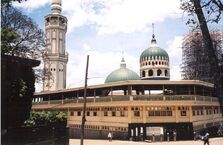
Islamic Center in Marawi City
As you may now know, the Moro people are Muslims. Islam has been a defining aspect of Moro culture and they worked diligently to avoid religious conversions by Catholic bishops and defend Islam in the archipelago or at least in the southern parts of the Philippines.
Most Moros are adherents to Sunni Islam or Folk Islam, which is a mix of Islamic and and pre-Islamic Animistic-Buddhist traditions. A Shiite minority exists, those who intermingle into Iranian expatriot families.
The presence of Jersuit missionaries in Mindanao had threatened the presence of Islam in the region. At one point, even in Mindanao, Islam was at the brink of becoming an extinct religion. During the Spanish era, Jesuit missionaries did succeed in converting clans of Tausūg and Yakan people to Christianity, almost all of their descendants today have converted or reverted to Islam. Marawi City is governed under the Islamic jurisdiction known as the Shariah.
The term Moro can also refer to the natives of Mindanao and the Sulu Archipelago, there are Christians among predominantly-Muslim groups such as the Bajaus and Yakans who follow either Islam or Christianity, those who follow the un-Hispanized culture in the Philippines.
Art[]
Visual Art[]
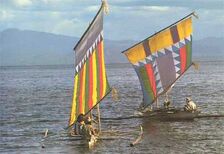
Vintas from Zamboanga City
The indigenous culture of the Moro people are well-renowned for its colorful art, especially for the groups that follow Folk Islam or still follow pre-Islamic folk practices. The Tausūg people of Sulu and the Zamboanga Peninsula are known for their colorful boats, known as vintas. The sarimanok is a legendary bird that dominates the art of the Maranaoan people. The Moro people were also renowned for being skilled swordsmiths, producing swords known as a kris and a dagger known as the barong (not to be mistaken for the Filipino attire of the same name). The kris sword has become a very symbolic weapon for the Moro people, the Moros had used these to fight the Spanish and American conquests.

The barong dagger
The Moro people are also skilled weavers and tailors. Women wear a traditional clothing known as a malong, which is a colorful woven cloth wrapped around the body. The patadyong is worn by both men and women, which is a lerge length of fabric wrapped around the waist, it is very similar to the sarongs of Indonesia and Malaysia.
Maguindanaoan and Maranao men wear a headgear known as a tobao, which is called a ppis in Sulu which has geometric designs and Arabic calligraphy.[17]
Music[]
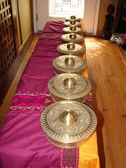
kulintang
The music of the Moro people is very indigenous and traditional, and the unifying music of the Muslims of the southern Philippines revolves around the kulintang, which is a gong ensemble popular in eastern Indonesia, Malaysia and the southern Philippines. The kulintang is commonly played with sticks like a lyre. The larger gongs, which are suspended vertically are known as agungs, which accompany a kulintang ensemble. The agung and the kulintang are people among both the Muslim and
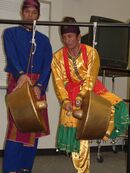
Maguindanaons playing the agung
the non-Muslim groups of the southern Philippines.
Dancing is a common Austronesian tradition, the groups of the Philippines and Indonesia are no exception. Filipino dances are known a fiestas, or sinulog, but because these tend to favor Roman Catholicism and its arrival in the Philippines, the Moros perform their own traditional dances and parades, many of them performed during weddings and festivals.
The Maranaoan folk dance is known as the singkil, which is the Maranoan interpretation of the Indian epic the Ramayana. The Tausūg people perform the pangalay. As usual, these are accompanied by kulintang and agung ensembles.
Architecture[]
Moro architecture is more or less influenced by Malay and mainstream Islamic architecture. Most of the earliest mosques in the southern Philippines were built of wood, until the arrival of major powers.
Some Moros such as the Tausūg and Bajau people are seafaring ethnic groups that don't have a permanent settlement on land.
Cuisine[]
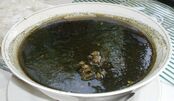
tiyula itum
The native cuisine of Mindanao resembles those of Malaysia and Indonesia, and contains Indian and Arab influence and other components not found in the culinary traditions outside of Muslim Mindanao. Compared to the cuisine of other regions in the Philippines which tend to be sweetened, Moro cuisine is rather rich in spices. Typical ingredients of the Moro people include chili, turmeric, sambal, coriander, lemongrass and peanut butter. Because Islamic laws prohibit pork consumption,
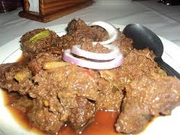
Mindanao-style rendang
pork and alcohol are absent in the native cuisine of the southern Philippines. Satay, which is a skewered snack consisting of various meats or seafoods in a sweet sauce is eaten in its pure form in the southern Philippines, known as satti as opposed to the variant eaten in the other parts of the Philippines which is a pork snack that Filipinos refer to as barbeque. Pyanggang is a barbeque-chicken dish marinded in spices made with toasted coconut meat. Tiyula itum
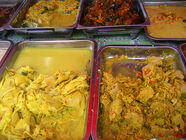
A food stall in Quiapo selling Maranaoan food
is also a Tausūg dish, which is a beef soup that consists of burnt coconut meat. Ginataang manok, chicken cooked in a spicy coconut milk is also popular in Mindanao.
Rendang is a spicy beef curry dish, that was introduced from the Minangkabau people of Indonesia. The Turkish rice dish known as pilaf is also eaten as kiyonig, and the Indian rice dish known as biryani, or nesi biryani in Malay. The only other region outside of Muslim Mindanao where biryani can be found is the province of Pampanga in Luzon.
Food is of great value to the Maranaoan people. Piarun a odang is a spicy-shrimp dish popular with the Maranaoan people. The chicken variant, piarun a manok is also available.[18]
Notable Moros, Filipino Muslims[]
|
Jamalul Kiram II |
The 32nd sultan of Sulu, the Spaniards were led eventually to deal with him as the Sultan of Sulu in spite of his repeated refusal to go to Manila on a state visit. Jamalul-Kiram II died on June 7, 1936. In 1915, he virtually surrendered his political powers to the United States government under the 1915 Carpenter Agreement. Jamalul Kiram II died without leaving any children. |
|
Nur Misuari |
A Moro politician from the Philippines who is the founder and leader of the Moro National Liberation Front, and also worked as a lecturer at the University of the Philippines |
|
Rajah Sulayman |
The rajah of the Kingdom of Maynila (and later Tondo) from Luzon who tried to accept the Spanish friendship without converting or giving up his land he led a rebellion with companion Lakan Dula against the Spanish armies, one of the Three Kings of Manila |
|
Tarik Sulayman |
The alleged Kapampangan leader from Macabebe that led native forces to battle Spanish forces in the Battle of the Bangkusay Channel in Tondo, the people of Macabebe consider him the first Filipino martyr over the nationally favored Cebuano warrior Lapu-Lapu |
|
Muhammad D. Kudarat |
Fifth sultan of Maguindanao, a descendant of Kabungsuwan who defeated Spanish forces in Maguindanao and emerged as Mindanao's most powerful Muslim ruler, became a Philippine National Hero under the presidency of Ferdinand Marcos |
| Datu Piang | A prominent datu from Cotabato, he was born to a Chinese father and a Maguindanaon mother (he was a mestizo), he was the undisputed Moro leader of Central Mindanao at the time of American administration, his son, Gumbay Piang led the Moro-Bolo Battalion against the Japanese forces during World War II. |
| Salipada Pendatun | A Philippine lawyer, military officer and statesman of the Maguindanaon ethnicity, he is the first Filipino Muslim to hold these offices. He fought against the Japanese during World War II, forming the Bolo Battalion, he held the position as a Brigadiere General in the armed forces, when he was the governer of the Cotabato Province, it was the most prosperous province in the island of Mindanao |
| Sheikh Ahmad Bashir |
Filipino Muslim Ālim, former president and founder of the Agama Islam Society. He grew to be a very influential Muslim leader in the Philippines, and helping found many Islamic studies in Mindanao. He received numerous awards from Muslim organizations in the Philippines. He is of the Maranaoan ethnic group, from Lanao del Sur. |
| Aleem Said Ahmad Basher |
A Saudi-born Filipino-Muslim Alim of the Maranaon ethnicity, an active and influential Islamic preacher, broadcaster, lecturer and Islamic consultant (an expert / resource person). He is the current chairman of the Imam Council of the Philippines. A Muslim leader and Imam, who tends to the community development, social needs and spiritual guidance of Muslim citizenry specifically those who are living in the Islamic communities in Metro Manila areas, and its nearby provinces in Luzon. |
|
Tucao O. Mastura |
An influential politician of the southern Philippines, a descendant of Sultan Muhammad D. Kudarat of Maguindanao who belongs to the Mastura political family in Mindanao, rival of the Ampatuans who committed the gruesome Maguindanao massacre he is the current mayor of Sultan Kudarat municipality in the province of Maguindanao |
| Nina Rasul | Real name is Santanina Tilla Rasul, a Filipina statesman and senator, who is the first Muslim member of the Senate of the Philippines, she also spearheaded projects and movements aimed towards gender equality, such as the role of women in the Philippine military, in 1990 she was designated as the Honorary Ambassador of UNESCO |
| Mujiv Hataman |
A Filipino politician and current Regional Governor of the Autonomous Region in Muslim Mindanao after being appointed by President Benigno Aquino III. He represented the Anak Mindanao party-list in Congress from 2001 to 2010. |
Sources[]
- ↑ CIA - The World Factbook "Philippines"
- ↑ 222. "Rajah Soliman". National Heroes. Globalpinoy.com. Retrieved February 5, 2008.
- ↑ Tantingco, Robby (October 24, 2006)."First Filipino martyr for freedom". Sun Star Pampanga
- ↑ First Battle of Bud Dajo
- ↑ U.S. Army Special Operations in World War II Hogan, David W.
- ↑ Nelly van Doorn-Harder. "Southeast Asia, Islam in." Encyclopedia of Islam and the Muslim World. Edited by Martin, Richard C. Macmillan Reference, 2004. vol. 1 p. 647.
- ↑ James R. Arnold, The Moro War: How America Battled a Muslim Insurgency in the Philippine Jungle, 1902-1913 (Bloomsbury Press; 2011) 306 pages
- ↑ Moro National Liberation Front Britannica.com
- ↑ UPDATED: Ampatuan Sr. loses to Mastura; Mangudadatu is new gov
- ↑ Zonio, Aquilies (2009-11-24). "Inquirer man recounts harrowing tales of survival". Philippine Daily Inquirer. Retrieved 2009-11-25.
- ↑ Solmerin, Florante S. (2009-12-04). "Lab results: 5 women showed signs of rape - /2009/december/4". Manila Standard Today. Retrieved 2009-12-06.
- ↑ Tran, Mark (2009-11-26). "Philippines massacre: police charge local politician with murder". The Guardian (London). Retrieved 2009-11-26
- ↑ "Islam in the Philippines" Retrieved 2013-9-11
- ↑ International Religious Freedom Report 2010, U.S. Department of State.
- ↑ Andong, Lore Mae (30 August 2011). "Muslims flock to Philippines' largest mosque". ABS-CBN News. Retrieved 7 February 2012.
- ↑ Armstrong, Paul and Schwarz, Tim (September 9, 2013). "Muslim rebels hold 20 hostages in Zamboanga City, Philippines". CNN. Retrieved September 26, 2013.
- ↑ "Heritage of the Philippine Muslims" Retrievd 12-9-2013
- ↑ "Introduction to Maranao Cuisine"











